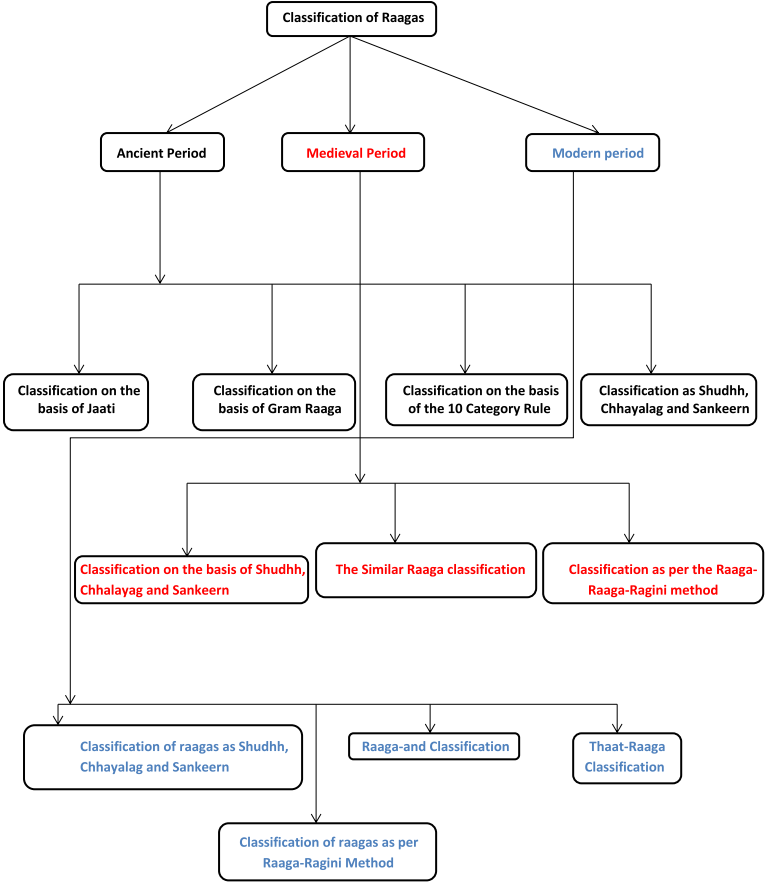
So this is the third and the last article in the series which is based on the classification of Raagas in the ancient, medieval and the modern period. I have already explained the classification of the raagas as per the ancient and the medieval period, this article will focus on the modern period classification of raagas. You must refer the link to these two previous articles for a better understanding of this concept (Classification Of Ragas In The Medieval Period- http://edtimes.in/2014/11/classification-ragas-medieval-period.html; Classification Of Raagas In The Ancient Period- http://edtimes.in/2014/10/classification-raagas-ancient-period.html )
Classification of raagas as per modern period-
- Classification of raagas on the basis of Shudhh, Chhalayag, and Sankeern.
- Classification of raagas as per the Raaga-Ragini method.
- Raaga-ang classification
- The Thaat-Raaga classification
Classification of raagas on the basis of Shudhh, Chhalayag and Sankeern
This classification was practised for some years but it has declined in the modern period.
Classification of raagas as per the Raaga-Ragini method
This classification as discussed in the last article started in the medieval period, but it has gradually declined now and is practised very rarely by some scholars and musicians.
Raaga-ang classification
A scholar named Swami Narayan Moreshwar Khare invented a new method of classification of raagas wherein; he formed 30 permutations of 4-5 swaras and classified all the raagas according to them and named the patterns on the name of the raaga. For example he formed a pattern- Ga Ma Re Sa and Ga Ma re Sa; he classified the 1st pattern as Bilawal and the 2nd one as Bhairav. He made 30 such patterns and classified according to them. Some of these pattern names are- Bhairav, Bhairavi, Bilawal, Kalyan, Khamaaj, Kaafi, Purvi, Marwa, Todi, Kannada, Malhar, Sarang, Bageshri, Lalit, Asavari and so on. This classification was also not successful and declined over a period of time.
Thaat- Raaga classification
The similar raaga classification explained in the 2nd article was later known to be the Thaat-Raaga classification. Pt. Vishnu Narayan Bhatkhande classified all the raagas according to 10 major groups known as thaats as follows-
- Bhairav
- Bhairavi
- Kaafi
- Khamaaj
- Asavari
- Kalyan
- Todi
- Marwa
- Bilawal
- Purvi
These thaats are made according to the similar characteristics of their raagas and it is named after the raaga whose characteristics define the nature of the thaat.
The key features of each thaat are already explained before. You may refer http://edtimes.in/2014/04/hindustani-music-part-8-insight-raags-thaats.html
The classification on this basis focuses more on the mood and the presentation style of the raaga instead of its structure. For example Raaga Bhoopali and Raaga Deshkar have similar swaras but are presented differently; so these two are classified under two different thaats and similarly Raaga Vrindavani Sarang which is classified under the thaat Kaafi should be classified as under Khamaj as per its swara structure.
This classification of raagas has been most apt till now but still, it has some short-comings. Raaga Patdeep, Raaga Lalit, Raaga Madhuvanti and many more could not be categorised into any thaat because of their different ways of presentation. Similarly Raaga Bhairav Bahar, Raaga Chandrakauns and Raaga Ahir Bhairav are not classified into their appropriate thaats; different scholars classify them into different thaats. In spite of these shortcomings this classification is practised world-wide by all Hindustani musicians.
So that’s all about classification of raagas in different times. Do have a look at the flow chart below on the summarization of this classification.
Now I’ll explain Raaga Des in brief-
Aaroh- Sa Re Ma Pa Ni Sa
Avroh- Sa ni Dha Pa Dha Ma Ga Pa Ma Ga Re Ga Ni Sa
Vadi Swara- Re
Samvadi Swara- Pa
Jaati- Audhav-Sampoorn
Time of singing- 2nd prahar of the night
This raaga is performed by almost all the singers in their performances. It has a very soothing effect on the listeners and also brings in a sensation of joy in them. It is sung in the night and is of Audhav-Sampoorn jaati i.e. 5 swaras in Aaroh and all the 7 swaras in the Avroh. The famous patriotic song of India- Vande Mataram is based on this raaga. The swara “Re” is very prominent in this raaga and generally a singers focuses on Re while doing the andolan. When a swara is sung repeatedly; it is known as andolan on that swara. The Aaroh of this Raaga has Shudhh Ni and the Avroh has a komal ni. Raaga des is very similar to Raaga Tilak Kamod so it takes quite a skilful rendition to avoid the mixing of these raagas.
You can listen to the rendition of this raaga by some great exponents of our Hindustani music-
- Raaga Des by Pt. Jasraj (Vocal)- https://www.youtube.com/watch?v=9KkHDdq_1H4
- Raaga Des by Ustad Amjad Ali Khan (Sarod)- https://www.youtube.com/watch?v=3utGH37HzCk
- Raaga Des by Pt. Shiv Kumar Sharma (Santoor)- https://www.youtube.com/watch?v=0CjYshWuJOo
- Raaga Des by Pt. Ravi Shankar (Sitar)- https://www.youtube.com/watch?v=CW4vZ3jLnDQ
Hoped you like this article. Thank you for your wonderful responses on my articles. Do let me know if you want me to write on any particular topic. Have a look at the flowchart below for a quick summary of my last 3 articles. Do Read, Share and Comment on my articles.
Thank You
Shubham Mittal































